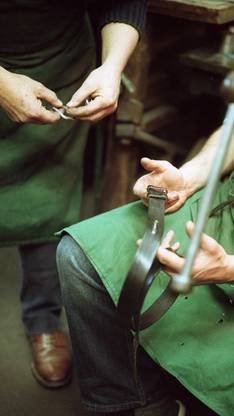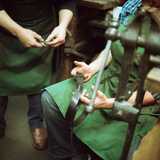Goldsmiths / London
Striking gold
At a small workshop in London’s Hatton Garden jewellery district, master goldsmith Gareth Harris oversees the production of fine metalwork while passing on time-honoured skills to his apprentice, Stavros Constantinou.

Master goldsmith Gareth Harris is rummaging for a twig in a box of solid gold, baling twine and cast silver frogs, the inspiration for his latest project. The twig, which fell onto his head during a walk in London’s Highgate Wood, has been transformed with a series of moldings and castings into a perfect solid silver reproduction that retains the fine grain of the original. Soon, it will be crafted into a belt buckle and sold on Savile Row. “In our private work we can afford an element of play,” says Harris, who stands in a fisherman’s jumper and corduroys next to a cluttered work bench. “Play is where you push yourself and discover where you want to be.”
Harris has earned the right to experiment during the 30 years his company has been in Hatton Garden, London’s jewellery quarter. There is a tradition of skilled metalworking in the district stretching back a thousand years: armourers equipped the Knights Templar from nearby Fetter Lane and the machine gun was invented here. “Some of the tools we use are over 400 years old,” says Harris.
Another constant in the trade is apprenticeship, a tradition that stretches back as long as the involvement of the Goldsmiths’ Company guild, which has regulated the industry here since 1300. When we meet Harris’s current apprentice, Stavros Constantinou, he is carefully bending a piece of silver into the shape of a belt buckle. He turns to his master and asks him to check the results as the edge of the metal has risen irregularly with the stresses of the process. Harris peers at the buckle. “I think we keep the imperfections,” Harris says approvingly.
The firm has also worked with artists, creating work for them in silver and gold. These collobarations started in the late 1990s with the Swiss-German artist Rolf Sachs (see our film Typisch Deutsch on monocle.com) and other commissions followed. Constantinou has also been involved in technical work for artists such as Damien Hirst and Marc Quinn but feels most affinity for the work of Anish Kapoor. “I’m a big fan of his work,” he says.
Constantinou arrived at the firm in 2004 following a degree in jewellery and silversmithing at London Metropolitan University. There, he studied under Harris’s co-founder, Dennis Smith, and first visited the workshop to finish his final-year piece, a church lantern (his uncle is a Greek Orthodox priest). He immediately impressed the partners with his skill and character. “Considering the sort of people we deal with and the nature of our materials, trust is a huge part of the business,” says Harris.
Constantinou’s education contrasts markedly with Harris’s own more formal training, first a traditional one-year pre-apprenticeship and then a formally bound five-year contract with Padgett and Braham, a now defunct specialist gold and silver box maker. This was 1975 and a long way from the Victorian boom years. The industry was on the wane and only two of the six apprentices Harris trained with got jobs. But the decline led to the trade restructuring into its current form, where, according to Harris, “Small, one or two-man outfits are really taking off. We’ve gone back to a pre-Victorian, 18th-century model with lots of small workshops, all interrelated.” Harris encourages Constantinou to talk about his training and his inspirations. Constantinou has studied Mayan metalwork and enjoys making big pieces, looking to create an “innocence” in his work. Harris’s own innovation is proved by a number of dazzling pieces he produces from his safe to illustrate his point: a series of “tumble cups” so called for their ability to withstand the hustle and bustle of stagecoach travel. Harris has radically modernised the design by adding a lattice-work base to the cup to illustrate the arcs of the tumbling piece.
This complex play of ideas, technologies and histories is working for the goldsmiths’ trade in London. One-time competitors in Paris and Augsburg have seen their ancient guild structures fall away and yet the Goldsmiths’ Company in London recently invested £17.5m (€20.9m) in the Goldsmiths’ Centre, a training facility with subsidised workshops that opened in 2012. Commenting on whether Constantinou is ready to strike out alone, Harris is candid. “Oh, there’s no question. But it’s a dreadfully expensive way of life here. It’s always a matter of managing your artistic temperament and the hard economic factors. Setting up on your own is always a leap of faith.”


